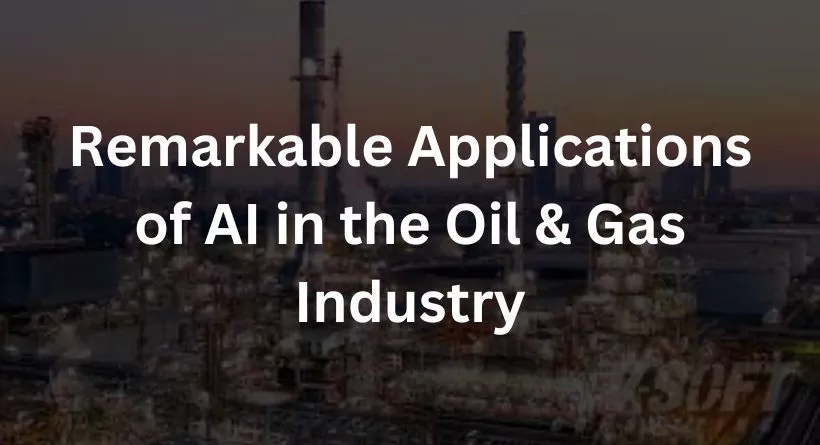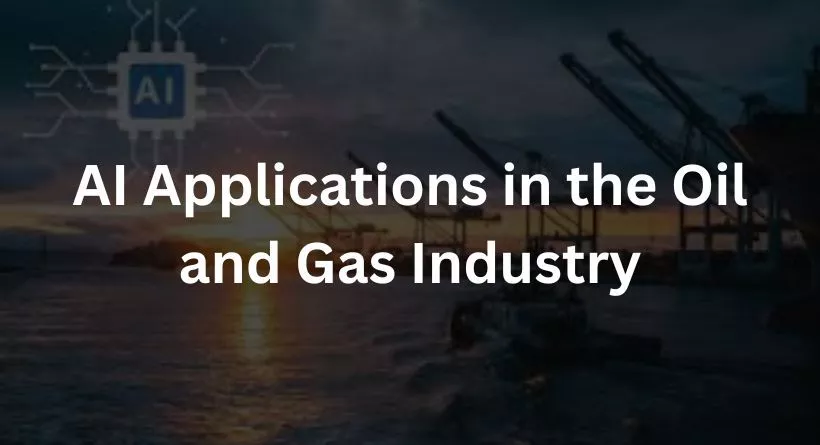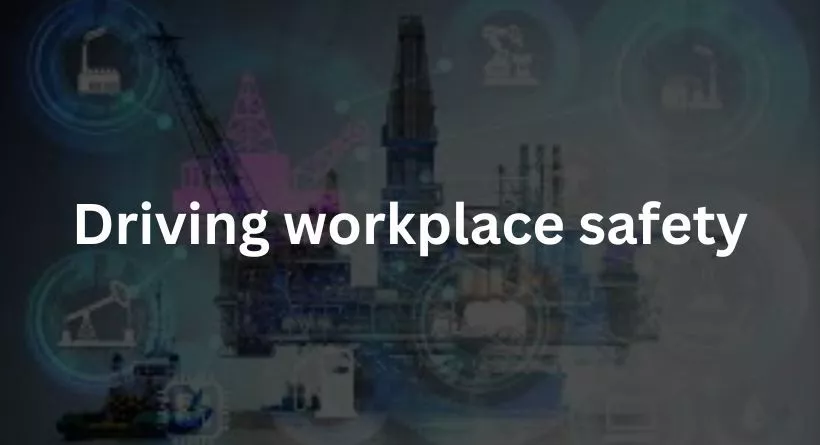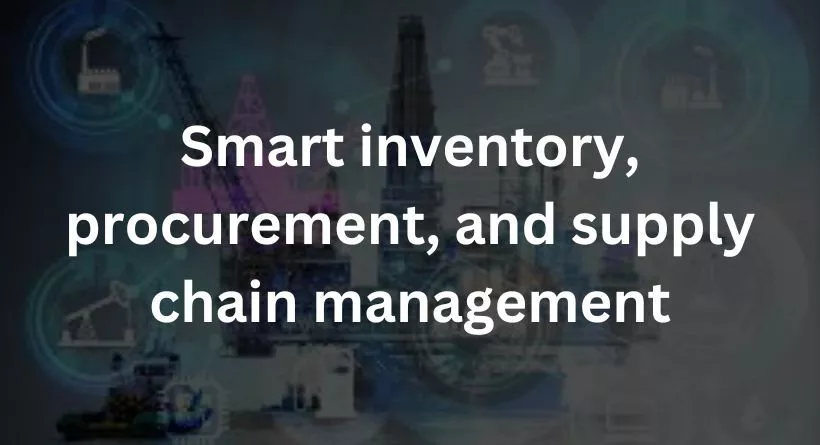
Even though it appears to be one of the most profitable industries to work in, the oil and gas (O&G) sector has faced a number of difficulties recently. The sector is beset by challenges that are hard to overcome, including as evolving demand, shifting regulations, supplier diversity, quickly expanding infrastructure and the frequent asset outages that follow, isolated operations, and environmental, social, and governance (ESG) issues.
Specifically, with growing worries about advancing a green, zero-waste agenda, demand to cut carbon dioxide and other harmful emissions is constant in the oil and gas sector.
As a result, O&G is investigating the enormous potential of Artificial Intelligence (AI) applications, just like any other industry, in order to improve security, raise efficiency, and facilitate sustainable operations.
In the oil and gas value chain, artificial intelligence has created a wide range of new opportunities. It has made it possible to manage assets in a proactive and predictive manner, improve data-driven decision-making, create a connected workforce, and guarantee worker health and safety.
AI Applications in the Oil and Gas Industry

It is true that “technologies like AI and machine learning can analyze the past, optimize the present, and predict the future,” as stated by Microsoft’s Corporate Vice President of Energy, Darryl Williams.
Let’s examine how AI/ML technologies are becoming “digital champions” in the oil and gas industry in light of this idea.
You may also like reading: Generative AI Applications in the Oil & Gas Industry
1. Smart asset management using Digital Twins
The oil and gas (O&G) business requires constant asset management, repair, and monitoring due to its asset-intensive nature. 63% of oil field assets have outlived their anticipated lifespans, according to studies. Because of this, equipment dependability is a serious problem that calls for data-driven asset management and upkeep.
In this sense, asset management and maintenance in the oil and gas sector have undergone a radical transformation thanks to the idea of digital twins.
What is a Digital Twin?
A digital twin is a replica of an actual on-field asset.
It allows for the virtual monitoring of on-field assets by simulating the characteristics and properties of a physical asset, such as pipelines, compressors, turbines, and pumps. It enhances asset performance by utilizing dependable, superior data.
A centralized repository of asset data is produced when the digital asset is updated with all current operational data, such as schematics, operating information, maintenance history, and troubleshooting procedures. AI algorithms are continuously analyzing this data bank. Algorithms for machine learning detect deviations from typical patterns to facilitate the following:
- To collect real-time sensor data in order to identify the early warning signs and phases of asset failure and to facilitate proactive equipment maintenance. This lowers the cost of operating and controlling O&G assets, avoids unscheduled downtime, and increases asset life.
- Reduce the need to recruit expensive maintenance staff and make frequent trips between the field and the office to cut down on the high expenses associated with asset upkeep.
2. Driving workplace safety

Intelligent artificial intelligence (AI), machine learning, the Internet of Things (IoT), and big data track field activities to detect potentially catastrophic indicators like dangerous gas concentrations and unapproved personnel entry.
Then, AI-enabled chatbots provide real-time notifications on smartphones and wearable smart devices, allowing workers to be on the field and fostering a more connected workforce. Examples of these alerts include lockout or health emergencies.
In addition, field operators may track their location, monitor worker activities, detect symptoms of worker weariness, and get vital information with the use of smart watches, safety helmets, biometric vests, and Bluetooth tags.
When necessary, IoT and AI may transmit alerts to deploy specialists or identify and resolve on-site problems in real time.
3. Optimizing production and scheduling
Overspending on the budget and timeline is a regular issue that befalls offshore oil projects. Here, variables like inclement weather, resource shortages, and schedule hazards are crucial.
The several isolated tasks that comprise the buildup phase of oilfield development, including as drilling and platform installation, add to the process’ complexity. Finding reliable project planning and scheduling models that take into account the interconnectedness of these interacting components and the associated risks is crucial in this situation.
Cloud-based solutions use AI algorithms and strong analytics to analyze incoming data and look for abnormalities that might indicate problems with the equipment they are monitoring.
4. Analytics-based decision-making
Oil and gas industries generate reams of siloed data from several business lines and operations across various areas. In addition to many other things, this data contains information on shipping and transportation, performance and recovery, drilling time, seismic and micro seismic data, and reservoir characterization. But these companies often don’t have the ability to use this information to make meaningful and perceptive decisions.
Hiring data scientists to examine this data doesn’t cost any money or time. Artificial intelligence (AI) may be used to create a unified data platform with knowledge-mining capabilities. This will allow information to be searchable and useful predictions to be extracted.
The most revolutionary technologies in 2021 were industrial IoT, analytics, AI, and machine learning (ML).
Oil and gas companies may do the following through the integration, analysis, and visualization of such heterogeneous data (using ML, big data analytics, and mobile devices):
- Determine the best places to drill in order to maximize output.
- Examine the drilling’s economic feasibility in order to maximize production costs and boost productivity.
- Activate proactive asset upkeep.
- Streamline scheduling, procurement, and inventory management.
- AI chatbots may respond to employee inquiries, deliver status updates on demand, and transmit the necessary data for on-the-ground AI and machine learning. -driven multi-layer security and multi-authentication to safeguard data that is essential to business.
5. Smart inventory, procurement, and supply chain management

Enterprise resource planning (ERP) is enhanced and inventory, logistics, and warehouse management are optimized in the oil and gas sector via artificial intelligence (AI), machine learning, smart track-and-trace technology, and cloud networks. They also make digital category management, replenishment, shipment transparency, and smart procurement possible.
Fleet data, including inventory, fuel consumption, and vehicle performance, is transmitted via IoT-connected sensors and intelligent devices to plan maintenance and prevent equipment failure.
The material master request (MMR) permission process may be digitalized and automated using low-code AI-based ERP systems. This will reduce the need for human interaction, speed up document review, do away with paper-based material request approvals, and ensure 100% correctness and traceability in the MMR process.
6. Optimization of back-office procedures
Numerous back-office tasks in the oil and gas industry may be automated to boost productivity, save costs, and save time.
Gas and oil CIOs need to implement technology in order to automate the subsequent procedures:
- Oil and gas-related papers are parsed by intelligent automation solutions that employ AI, NLP, and OCR to accurately extract the necessary information. For instance, bills, shipping paperwork, resumes of candidates, etc.
- Artificial intelligence (AI)-enabled bots streamline certain recruiting procedures by reviewing applications, gathering pertinent data, and generating emails about applicant selection on their own.
- AI bots may automate a laborious and time-consuming operation by extracting data from invoices in a variety of formats and entering it into backend systems.
- To guarantee adherence to industry standards, automatically collect, evaluate, and organize regulatory data.
- The Authorization for Expenditure (AFE) process may be automated by enhancing accountability, enhancing transparency and openness in operations, and producing automated reminders and notifications.
- To save time and paper, automate the whole Master Material Request (MMR) form approval process by monitoring approvals, allocating duties, and sending out alerts and reminders.
- In addition to saving time and paper, low- or non-code Power Apps solutions provide 100% transparency and accuracy into the buy requisition/purchase order process, enable dashboard customization for PR, PO, GR, and invoice status, and provide form validation.
How can Acuvate support you?
In order to create corporate apps and platforms that facilitate intelligent analysis and collaboration, Acuvate leverages powerful, cutting-edge technologies like artificial intelligence (AI), big data analytics, the Internet of Things (IoT), and cloud computing. This redefines information orchestration and operations in the oil and gas sector.
Our innovative and environmentally friendly digital solutions modernize asset management, create a linked value chain, protect worker health and safety, and increase productivity through data-driven choices, all while transforming operations throughout the oil and gas value chain.
Conclusion
In conclusion, AI is reshaping the oil and gas industry, from proactive asset management to streamlined back-office procedures. Embracing these technologies is not just a choice; it’s a necessity for staying competitive, efficient, and environmentally responsible.
FAQs
How can AI improve workplace safety in the oil and gas industry?
AI, through real-time monitoring and smart devices, detects potential hazards and ensures a connected workforce, fostering a safer work environment.
What role does Digital Twins play in asset management?
Digital Twins, virtual replicas of on-field assets, enable proactive and data-driven asset management, reducing operational costs and preventing downtime.
How does AI optimize production in offshore oil projects?
AI algorithms in cloud-based solutions analyze data to identify abnormalities, ensuring optimal production, tackling schedule hazards, and enhancing the oilfield development process.
What benefits does AI bring to analytics-based decision-making in the oil and gas industry?
AI creates unified data platforms with knowledge-mining capabilities, allowing companies to make informed decisions, maximize output, and activate proactive asset upkeep.
In what ways does AI revolutionize inventory, procurement, and supply chain management in the oil and gas sector?
AI, machine learning, and IoT optimize enterprise resource planning, ensuring correctness, reducing human intervention, and enhancing efficiency in inventory, procurement, and supply chain management.





